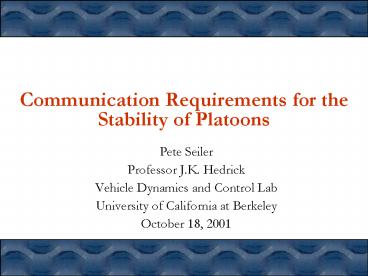Communication Requirements for the Stability of Platoons - PowerPoint PPT Presentation
1 / 18
Title:
Communication Requirements for the Stability of Platoons
Description:
Communication Requirements for the Stability of Platoons. Pete Seiler ... AHS are motivated by traffic congestion. and the desire to ... contraposition. ... – PowerPoint PPT presentation
Number of Views:31
Avg rating:3.0/5.0
Title: Communication Requirements for the Stability of Platoons
1
Communication Requirements for the Stability of
Platoons
- Pete Seiler
- Professor J.K. Hedrick
- Vehicle Dynamics and Control Lab
- University of California at Berkeley
- October 18, 2001
2
Automated Highway Systems (AHS)
- AHS are motivated by traffic congestion
- and the desire to increase capacity.
- PATH uses a platooning strategy
- Closely spaced vehicles travel in small
- platoons with large separation
- between the platoons
- Research on the control of vehicle
- strings dates back to the 1960s.
3
Simple Vehicle Following
- A reasonable strategy Use a radar to follow a
fixed distance behind the preceding vehicle. - Plant
- Error
- Controller
- Error Dynamics
4
Amplification of Errors
- Theorem Middleton and Goodwin, 1990 If H(s)
is a rational transfer function with at least two
poles at the origin and if the feedback loop is
stable, then the complementary sensitivity
function must satisfy - A simple consequence is that for any
- stabilizing controller there exists an w
- such that T(jw)gt1.
- Interpretation Errors with significant
- energy at this frequency will be amplified.
- This is commonly called string instability.
5
Error Amplification Example
6
Implications for Control
- Communication of leader information
- solves this problem
- Controller
- Error Dynamics
- Similar results on disturbance amplification
exist for a large class of bidirectional
controllers - If communication of leader information is not
possible, then performance requirements must be
weakened.
7
Communications and Control
- Motivation Wireless networks can be used to
solve the problem of error amplification. - Communication/Control Questions
- What information should be communicated?
- What are the limits of network performance for
acceptable control? - Develop tractable conditions for the following
- Analyze degradation in closed loop performance
due to network - Given a level of network performance, synthesize
a controller
8
Problem Setup
- Plant
- Network Model
- Augmented open loop model
9
Tools for Networked Systems
- The augmented open loop plant falls into the
general class of Markov Jump Linear Systems. - We have used filtering theory to determine
theoretical bounds on required network
performance for simple problems. - We have set up an optimization problem that
allows us to analyze the performance and/or
synthesize controllers for more complicated
networked control problems.
10
Platoon Example
- We will analyze the effect of the wireless
network on the performance of a 4 car platoon. - The vehicle model is discretized at a 20
msec sample rate. - Demo controller
- Lead and preceding vehicle information must be
communicated to each vehicle.
11
Platoon Performance vs. Packet Loss
12
Conclusions
- Local decentralized controllers lack
scalability since they are sensitive to
disturbances. This motivates the need for
communication between vehicles. - We developed a computationally efficient method
to analyze the effect of a network. This
algorithm can also be used for control design. - We used this algorithm to analyze the effect of
the network in a platoon of 4 cars.
13
Markovian Jump Linear Systems
- MJLS
- There are many definitions of stability
- Stochastic Stability
- Mean Square Stability
- Exponential Mean Square Stability
- Almost Sure Stability
- Theorem Ji and Chizeck, 1991 For a MJLS,
conditions 1-3 are equivalent and any one of them
implies 4.
14
H? Conditions
- Plant (P)
- If the plant is stable, define the H? norm as
- Theorem If pijpj for i,j1,,N then the MJLS is
stable and satisfies iff there exists
a matrix Ggt0 such that
15
Optimal Controllers
- Goal Find a dynamic output feedback controller
(or show that one fails to exist) such that the
closed loop system is stable and . We
assume the controller has the following form - Closed Loop State Matrices
- Applying the Theorem, the closed loop is stable
and iff there exists a matrix Ggt0
such that
16
Disturbance Propagation Theorem
- Theorem Given any Mgt0 there exists a platoon
- length such that for any
KLA(s) or for - any KBD(s) with no poles at the origin.
- Proof Outline
- For KLA, disturbances are propagated through
T(S). For example, the effect of d1(s) on eN(s)
is - The result follows since T(jw)gt1 at some
frequency. - For KBD, disturbances propagate in both
directions. The closed loop map simplifies to - First we show that has an
eigenvalue tending to zero as the platoon length
tends to infinity. We then construct the bad
disturbance from the corresponding eigenvector.
17
Conditions for Mean-Square Stability
- Theorem Costa and Fragoso (1993) The stability
of the MJLS is equivalent to the existence of
matrices Gigt0 for i1,,N satisfying any of the
following - Corollary If pijpj for i,j1,,N then the MJLS
is stable iff there exists a matrix Ggt0 such
that
18
H? Conditions Proof
- Theorem If pijpj for i,j1,,N then the MJLS is
stable and satisfies iff there exists
a matrix Ggt0 such that - Proof Outline
- Sufficiency follows from a stochastic Lyapunov
argument. - For necessity, we show that
implies that a related Riccati equation has a
solution. This is shown via contraposition.
This Riccati equality can easily be turned into a
Riccati inequality which leads to the specified
matrix inequality.































